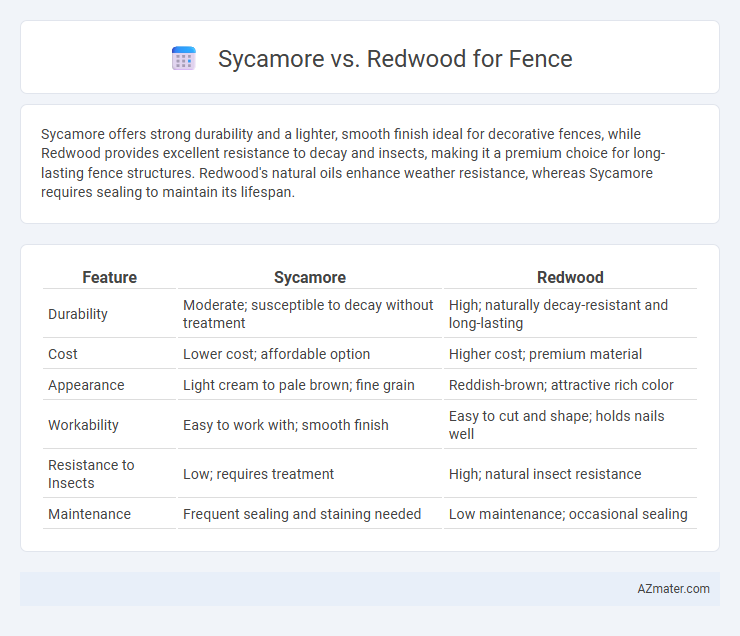Sycamore offers strong durability and a lighter, smooth finish ideal for decorative fences, while Redwood provides excellent resistance to decay and insects, making it a premium choice for long-lasting fence structures. Redwood's natural oils enhance weather resistance, whereas Sycamore requires sealing to maintain its lifespan.
Table of Comparison
| Feature | Sycamore | Redwood |
|---|---|---|
| Durability | Moderate; susceptible to decay without treatment | High; naturally decay-resistant and long-lasting |
| Cost | Lower cost; affordable option | Higher cost; premium material |
| Appearance | Light cream to pale brown; fine grain | Reddish-brown; attractive rich color |
| Workability | Easy to work with; smooth finish | Easy to cut and shape; holds nails well |
| Resistance to Insects | Low; requires treatment | High; natural insect resistance |
| Maintenance | Frequent sealing and staining needed | Low maintenance; occasional sealing |
Introduction to Sycamore and Redwood as Fencing Materials
Sycamore, known for its fine grain and light color, offers moderate durability in fence construction, making it suitable for decorative and light-use fencing projects. Redwood stands out with its natural resistance to decay and insects, combined with stability and rich reddish hues, making it a premium choice for long-lasting, high-quality fences. Both woods provide unique aesthetic and functional properties tailored to different outdoor fencing needs.
Appearance and Aesthetic Differences
Sycamore fence panels exhibit a light, creamy color with subtle grain patterns, offering a smooth, uniform appearance that complements modern or minimalist designs. Redwood fences showcase a rich reddish-brown hue with prominent, natural knots and grain variations, creating a warm, rustic aesthetic ideal for traditional or natural settings. The distinct color tones and grain textures of sycamore and redwood provide contrasting options tailored to different outdoor visual preferences and architectural styles.
Durability and Longevity Comparison
Sycamore wood offers moderate durability, with a tendency to resist decay for 5 to 10 years when properly treated, making it less ideal for long-term fence longevity. Redwood stands out for its natural resistance to rot, insects, and weather, often lasting 20 to 30 years or more without extensive maintenance. Choosing redwood over sycamore significantly enhances the lifespan and resilience of fencing against outdoor environmental factors.
Weather Resistance and Climate Suitability
Sycamore offers moderate weather resistance but is more prone to cracking and warping in extreme climates, making it less ideal for areas with high humidity or fluctuating temperatures. Redwood boasts superior weather resistance due to its natural oils and dense grain, which provide excellent protection against moisture, decay, and insect damage, especially in coastal or rainy environments. Choosing redwood for fencing ensures greater durability and longevity in diverse climate conditions compared to sycamore.
Maintenance Requirements
Sycamore fences require regular sealing and occasional sanding to prevent cracking and weather damage, while redwood fences naturally resist decay and insect infestation, needing less frequent maintenance. Redwood's stability and dense grain reduce warping and splitting, making it a low-maintenance choice for long-term fencing. Sycamore may demand more upkeep in humid or harsh climates due to its softer wood structure.
Environmental Impact and Sustainability
Sycamore wood used for fences offers moderate sustainability due to its relatively fast growth rate and renewability, supporting lower environmental impact through reduced carbon sequestration time. Redwood, prized for its natural resistance to decay and pests, reduces the need for chemical treatments, enhancing its eco-friendliness, although its slower growth rate raises concerns about long-term supply and habitat disruption. Choosing sustainably harvested sycamore or certified redwood from managed forests minimizes deforestation risks and contributes positively to environmental conservation efforts.
Cost and Budget Considerations
Sycamore wood generally offers a more affordable option for fencing compared to Redwood, with lower initial material costs making it suitable for budget-conscious projects. Redwood tends to be pricier due to its natural resistance to decay and insects, providing longer-lasting durability that can reduce maintenance expenses over time. Evaluating the balance between upfront investment and long-term value is key when choosing between Sycamore and Redwood for fencing.
Installation Ease and Workability
Sycamore offers moderate installation ease due to its consistent grain and relatively lighter weight, making it manageable for most fence projects. Redwood provides superior workability with its straight grain and natural resistance to splitting, allowing for easier cutting, nailing, and shaping during installation. Both woods require proper tools, but Redwood's durability and smooth texture often result in faster assembly and longer-lasting fencing outcomes.
Pest and Rot Resistance
Sycamore wood offers moderate pest resistance but is more prone to rot and decay when exposed to moisture, making it less ideal for fence durability in wet climates. Redwood, on the other hand, is highly resistant to both pests and rot due to its natural oils and dense grain, ensuring longer-lasting performance with minimal maintenance. Choosing redwood for fencing provides superior protection against termites and fungal attacks, significantly extending the fence's lifespan.
Which Wood is Best for Your Fence?
Sycamore and Redwood differ significantly in durability and resistance, making Redwood the superior choice for fencing due to its natural resistance to decay, insects, and weather conditions. Sycamore, while visually appealing, lacks the long-lasting hardness and moisture resistance essential for outdoor use. Choosing Redwood ensures a fence with enhanced longevity, minimal maintenance, and better value over time.

Infographic: Sycamore vs Redwood for Fence
 azmater.com
azmater.com